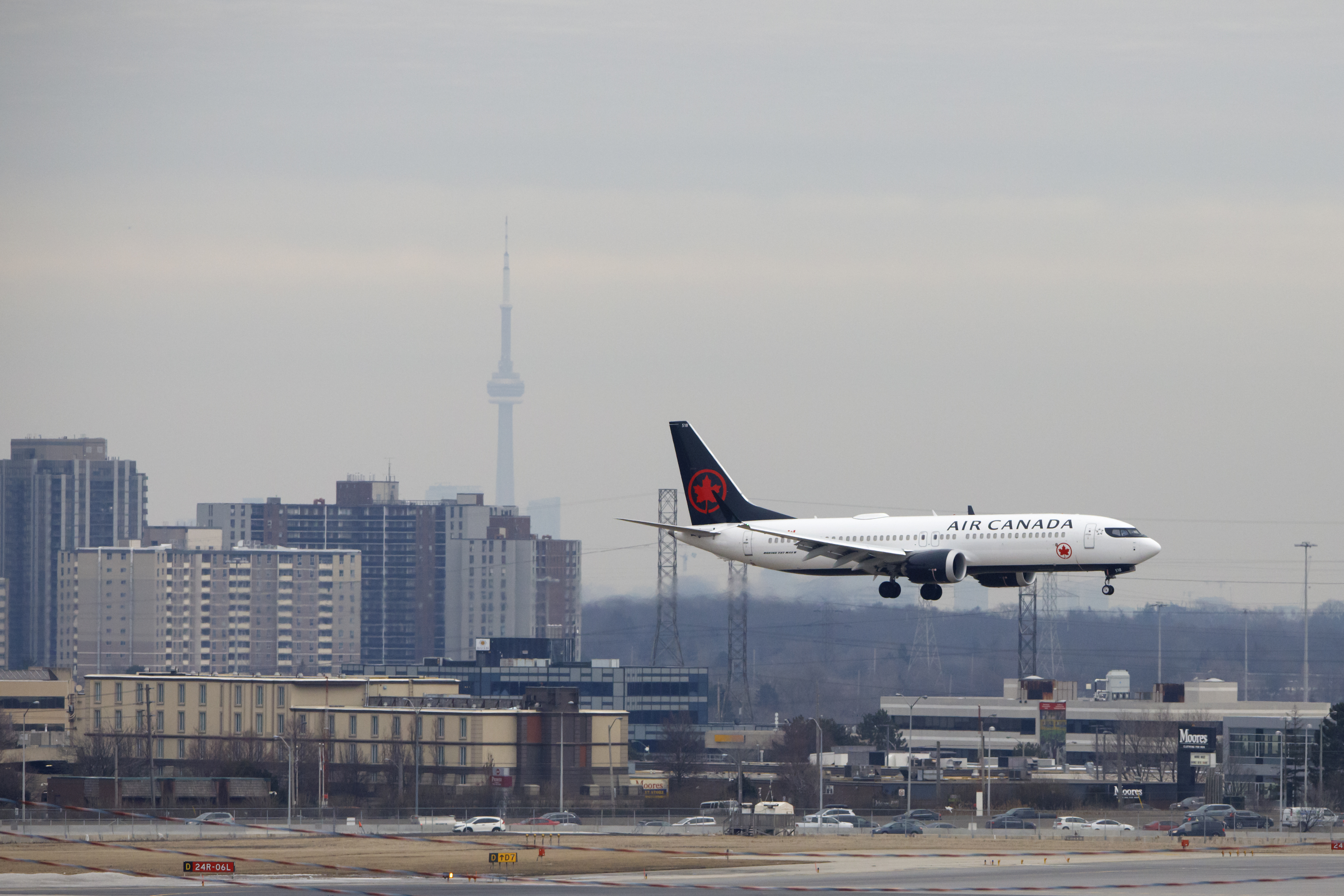
An Air Canada flight approaches Toronto Pearson International Airport for landing on March 13, 2019 in a file photo. (Photo by Cole Burston/Getty Images)
By
A Public Health Agency report submitted to a House of Commons committee says that the mandatory ArriveCan app travellers were required to use when entering and leaving Canada, under threat of fines if they didn’t, saved travellers “about five minutes” at border crossings.
“ArriveCan was a necessary component of Canada’s measures to prevent the introduction and spread of Covid-19 in Canada,” the Public Health Agency of Canada (PHAC) told the MPs of the committee in a submission on Nov. 14, 2022, as first reported by Blacklock’s Reporter on Jan. 6. “The information collected in ArriveCan was critical.”
“It saved about 5 minutes at the border for each traveller, which significantly reduced overall processing time and points of contact at ports of entry,” stated PHAC’s report to the House of Commons Standing Committee on Government Operations and Estimates.
ArriveCan cost $54 million, according to Blacklock’s Reporter.
It was created in response to a request made by PHAC to Canada Border Services Agency (CBSA) then-president John Ossowski in April 2020 to develop an application to collect traveller and health information.
In his Dec. 8, 2022, testimony before the committee, Ossowski, who left his CBSA position in June that year, said he recalled that “the average passage time per traveller was up to seven minutes long” at that time, in April 2020.
Comparing the figure Ossowski provided with the “about five minutes” time saving stated by the PHAC would mean it took travellers only two minutes to cross the border after ArriveCan was in place.
In April 2020, despite restrictions on entry at the time, around 70,000 travellers were exempt and allowed to fly into Canada, compared to nearly 3.2 million who arrived in April 2019, Ossowski said.
Union Disagreed
The seven-minute time saving figure noted in PHAC’s report contradicts testimony by the Customs and Immigration Union (CIU) in September 2022 that lineups were so long, travellers at land crossings soiled their clothing while waiting to clear the border, according to Blacklock’s Reporter.
“I am hearing from one of our officers at Niagara Falls that he’s had travellers who come through who had actually urinated and defecated themselves having been stuck in the car for so long, to give you an idea of how terrible and drastic the situation at our borders was and how terribly short-staffed we are,” testified CIU national president Mark Weber. “I think that says it all.”
“The greatest difficulty we had was people simply didn’t know they had to complete the app or we had cases where some people just refused to fill it out,” said Weber. “We had to deal with a good 30 to 40 percent of travellers arriving without it completed which caused the four or five-hour lineups that we saw.”
“It wasn’t so much a matter of not being able to,” said Weber. “It was simply not wanting to or not even knowing it was a requirement which more often than not was the issue.”
Audit
On Nov. 2, 2022, the House of Commons voted 173 to 149 to carry out an audit of the ArriveCan program as result of a motion introduced by Opposition Leader Pierre Poilievre.
“The app was unnecessary,” Poilievre said at the time. “Canadians have been able to cross the border without it for decades and even centuries. Why did this app suddenly become necessary?”
The audit will cover payments, contracts, and subcontracts for all aspects of ArriveCan, but no deadline has been announced for a final report.
Ossowski told the committee in his Dec. 8, 2022, testimony that ArriveCan was necessary.
In the early days of the pandemic, “travellers had to provide verbal responses to the CBSA officers making sure they were compliant with the myriad rules being established through various orders in council. The result, when combined with the need for social distancing, made airports chaotic scenes,” Ossowski said.
“Paper was being distributed to travellers to capture contact tracing and quarantine plan information,” and the CBSA was collecting “huge volumes of paper.”
“It was critical for federal and provincial health officials to have timely access to this data in order to slow the spread of the virus,” testified Ossowski.
According to the PHAC report presented to the committee, the agency “required a technological solution to digitize the collection of traveller information upon entry to Canada.”
“Heavy reliance on the travel contact information paper forms at the outset of the pandemic led to a number of inefficiencies.”
The federal government made the use of ArriveCan mandatory in November 2020 for air travellers seeking to enter Canada. Its use was subsequently suspended on Oct. 1, 2022.
While in use, ArriveCan collected data “to share with the provinces, which were desperate for this information,” testified Ossowski.
He said ArriveCan was linked with passports, provincial vaccination credentials, and CBSA systems “in real time,” and that an estimated 60 million travellers were allowed to cross the border by the CBSA officer simply seeing “a green check mark on the screen advising them that all border health requirements had been met.”
“The CBSA built in new aspects that helped validate the proof of vaccine certificates of foreign nationals using AI tools, as well as the ability to validate, in real time, critical provincial QR codes to make it easier for Canadian citizens,” Ossowski said.